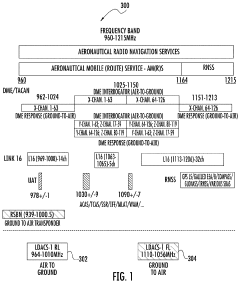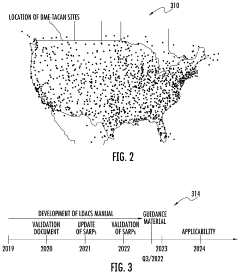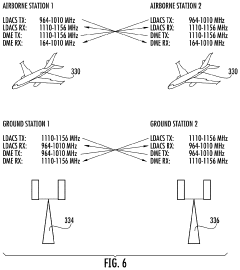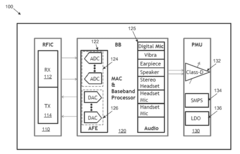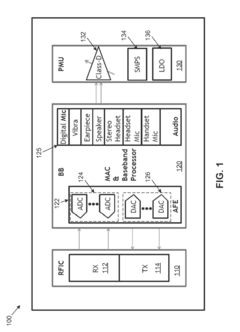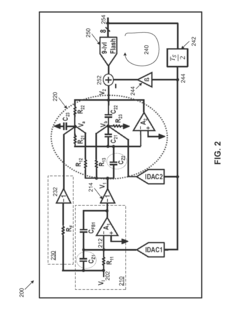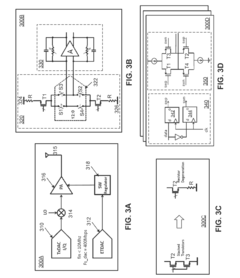How LDAC Improves Real-Time Audio Communications?
JUL 4, 20259 MIN READ
Generate Your Research Report Instantly with AI Agent
Patsnap Eureka helps you evaluate technical feasibility & market potential.
LDAC Technology Overview
LDAC (Low Latency Audio Codec) is a cutting-edge audio coding technology developed by Sony Corporation to enhance the quality of wireless audio transmission. This advanced codec aims to address the limitations of traditional Bluetooth audio codecs, particularly in terms of audio fidelity and latency reduction for real-time communications.
LDAC operates on the principle of high-resolution audio compression, allowing for the transmission of audio data at up to 990 kbps, which is significantly higher than conventional Bluetooth codecs. This increased bandwidth enables LDAC to preserve more audio information, resulting in a near-lossless audio experience that closely resembles the original source material.
The technology employs adaptive bit rate allocation, dynamically adjusting the compression ratio based on the complexity of the audio signal and the available wireless bandwidth. This adaptive approach ensures optimal audio quality across various network conditions and device capabilities.
One of LDAC's key features is its ability to maintain low latency, which is crucial for real-time audio communications. By utilizing efficient encoding and decoding algorithms, LDAC minimizes the delay between audio transmission and reception, enhancing the overall user experience in applications such as video conferencing, gaming, and live performances.
LDAC supports multiple audio formats, including PCM, DSD, and MQA, making it versatile for different audio sources and playback devices. It is compatible with various Bluetooth profiles, such as A2DP (Advanced Audio Distribution Profile), ensuring broad device support and seamless integration into existing audio ecosystems.
The codec incorporates advanced error correction and concealment techniques to mitigate the effects of packet loss and interference in wireless transmissions. This feature contributes to a more stable and reliable audio connection, particularly in challenging environments with multiple wireless devices or sources of electromagnetic interference.
LDAC's implementation in hardware and software systems involves optimized DSP (Digital Signal Processing) algorithms that balance computational efficiency with audio quality. This optimization allows for real-time encoding and decoding on a wide range of devices, from smartphones to high-end audio equipment, without significant power consumption or processing overhead.
As the demand for high-quality wireless audio continues to grow, LDAC represents a significant advancement in audio codec technology. Its ability to deliver near-lossless audio quality with low latency positions it as a key enabler for next-generation audio applications, particularly in the realm of real-time communications and immersive audio experiences.
LDAC operates on the principle of high-resolution audio compression, allowing for the transmission of audio data at up to 990 kbps, which is significantly higher than conventional Bluetooth codecs. This increased bandwidth enables LDAC to preserve more audio information, resulting in a near-lossless audio experience that closely resembles the original source material.
The technology employs adaptive bit rate allocation, dynamically adjusting the compression ratio based on the complexity of the audio signal and the available wireless bandwidth. This adaptive approach ensures optimal audio quality across various network conditions and device capabilities.
One of LDAC's key features is its ability to maintain low latency, which is crucial for real-time audio communications. By utilizing efficient encoding and decoding algorithms, LDAC minimizes the delay between audio transmission and reception, enhancing the overall user experience in applications such as video conferencing, gaming, and live performances.
LDAC supports multiple audio formats, including PCM, DSD, and MQA, making it versatile for different audio sources and playback devices. It is compatible with various Bluetooth profiles, such as A2DP (Advanced Audio Distribution Profile), ensuring broad device support and seamless integration into existing audio ecosystems.
The codec incorporates advanced error correction and concealment techniques to mitigate the effects of packet loss and interference in wireless transmissions. This feature contributes to a more stable and reliable audio connection, particularly in challenging environments with multiple wireless devices or sources of electromagnetic interference.
LDAC's implementation in hardware and software systems involves optimized DSP (Digital Signal Processing) algorithms that balance computational efficiency with audio quality. This optimization allows for real-time encoding and decoding on a wide range of devices, from smartphones to high-end audio equipment, without significant power consumption or processing overhead.
As the demand for high-quality wireless audio continues to grow, LDAC represents a significant advancement in audio codec technology. Its ability to deliver near-lossless audio quality with low latency positions it as a key enabler for next-generation audio applications, particularly in the realm of real-time communications and immersive audio experiences.
Audio Market Trends
The audio market has been experiencing significant growth and transformation in recent years, driven by advancements in technology and changing consumer preferences. The global audio market size was valued at $20.31 billion in 2020 and is projected to reach $31.80 billion by 2028, growing at a CAGR of 5.9% during the forecast period. This growth is primarily attributed to the increasing demand for wireless audio devices, smart speakers, and high-quality audio solutions across various sectors.
One of the key trends shaping the audio market is the shift towards wireless and portable audio devices. The convenience and flexibility offered by wireless technologies such as Bluetooth and Wi-Fi have led to a surge in demand for wireless headphones, earbuds, and portable speakers. This trend is further accelerated by the widespread adoption of smartphones and tablets, which serve as primary audio sources for many consumers.
Another significant trend is the growing popularity of smart speakers and voice-controlled devices. The integration of artificial intelligence and voice recognition technologies has revolutionized the way people interact with audio devices. Smart speakers have become central hubs for home automation and entertainment, driving market growth in both consumer and commercial sectors.
The rise of streaming services and digital audio content has also had a profound impact on the audio market. As more consumers shift towards on-demand audio consumption, there is an increasing demand for high-quality audio devices that can deliver superior sound experiences. This trend has led to the development of advanced audio codecs and technologies, such as LDAC, which aim to improve audio quality in wireless transmission.
In the professional audio segment, there is a growing demand for sophisticated audio solutions in various industries, including broadcasting, live events, and corporate communications. The need for high-quality, real-time audio transmission in these sectors is driving innovation in audio technologies and creating new market opportunities.
The COVID-19 pandemic has further accelerated certain audio market trends, particularly in the areas of remote work and virtual communication. The increased reliance on video conferencing and online collaboration tools has heightened the importance of clear, reliable audio in professional settings. This has led to a surge in demand for high-quality headsets, microphones, and audio processing technologies that can enhance voice clarity and reduce background noise in virtual environments.
One of the key trends shaping the audio market is the shift towards wireless and portable audio devices. The convenience and flexibility offered by wireless technologies such as Bluetooth and Wi-Fi have led to a surge in demand for wireless headphones, earbuds, and portable speakers. This trend is further accelerated by the widespread adoption of smartphones and tablets, which serve as primary audio sources for many consumers.
Another significant trend is the growing popularity of smart speakers and voice-controlled devices. The integration of artificial intelligence and voice recognition technologies has revolutionized the way people interact with audio devices. Smart speakers have become central hubs for home automation and entertainment, driving market growth in both consumer and commercial sectors.
The rise of streaming services and digital audio content has also had a profound impact on the audio market. As more consumers shift towards on-demand audio consumption, there is an increasing demand for high-quality audio devices that can deliver superior sound experiences. This trend has led to the development of advanced audio codecs and technologies, such as LDAC, which aim to improve audio quality in wireless transmission.
In the professional audio segment, there is a growing demand for sophisticated audio solutions in various industries, including broadcasting, live events, and corporate communications. The need for high-quality, real-time audio transmission in these sectors is driving innovation in audio technologies and creating new market opportunities.
The COVID-19 pandemic has further accelerated certain audio market trends, particularly in the areas of remote work and virtual communication. The increased reliance on video conferencing and online collaboration tools has heightened the importance of clear, reliable audio in professional settings. This has led to a surge in demand for high-quality headsets, microphones, and audio processing technologies that can enhance voice clarity and reduce background noise in virtual environments.
LDAC Technical Challenges
LDAC, while offering significant improvements in audio quality for Bluetooth transmission, faces several technical challenges in real-time audio communications. One of the primary obstacles is latency, which is critical for seamless real-time interactions. LDAC's high-quality audio encoding process inherently introduces additional processing time, potentially leading to noticeable delays in audio transmission. This latency can be particularly problematic in applications such as voice calls or live performances where immediate audio feedback is crucial.
Another challenge lies in the bandwidth requirements of LDAC. The codec's high bitrate, while beneficial for audio quality, demands more bandwidth than traditional codecs like SBC or AAC. This increased bandwidth consumption can strain Bluetooth connections, especially in environments with significant wireless interference or when multiple devices are competing for bandwidth. Maintaining a stable, high-quality connection under these conditions presents a significant technical hurdle.
Power consumption is also a considerable concern for LDAC implementation in real-time communications. The complex encoding and decoding processes required for LDAC's high-quality audio transmission consume more energy than simpler codecs. This increased power demand can lead to faster battery drain in portable devices, potentially limiting the practical usability of LDAC in mobile scenarios where long battery life is essential.
Compatibility and interoperability pose additional challenges. While LDAC has gained traction, it is not universally supported across all devices and platforms. This lack of ubiquitous support can create compatibility issues in real-time communication scenarios, where seamless connectivity between various devices and systems is crucial. Ensuring backward compatibility with existing audio systems while maintaining LDAC's quality advantages is a delicate balance that engineers must strike.
The variable bitrate nature of LDAC, while advantageous for adapting to different audio content and network conditions, introduces complexity in maintaining consistent audio quality during real-time communications. Rapid fluctuations in bitrate can lead to perceptible changes in audio quality, potentially disrupting the user experience. Developing robust algorithms to manage these transitions smoothly and imperceptibly is a significant technical challenge.
Lastly, the implementation of LDAC in real-time communication systems requires careful optimization of encoding and decoding processes to minimize computational overhead. This optimization is crucial for ensuring that LDAC can be effectively utilized across a wide range of devices, including those with limited processing power. Balancing the trade-offs between audio quality, processing requirements, and real-time performance remains an ongoing challenge for LDAC implementation in communication systems.
Another challenge lies in the bandwidth requirements of LDAC. The codec's high bitrate, while beneficial for audio quality, demands more bandwidth than traditional codecs like SBC or AAC. This increased bandwidth consumption can strain Bluetooth connections, especially in environments with significant wireless interference or when multiple devices are competing for bandwidth. Maintaining a stable, high-quality connection under these conditions presents a significant technical hurdle.
Power consumption is also a considerable concern for LDAC implementation in real-time communications. The complex encoding and decoding processes required for LDAC's high-quality audio transmission consume more energy than simpler codecs. This increased power demand can lead to faster battery drain in portable devices, potentially limiting the practical usability of LDAC in mobile scenarios where long battery life is essential.
Compatibility and interoperability pose additional challenges. While LDAC has gained traction, it is not universally supported across all devices and platforms. This lack of ubiquitous support can create compatibility issues in real-time communication scenarios, where seamless connectivity between various devices and systems is crucial. Ensuring backward compatibility with existing audio systems while maintaining LDAC's quality advantages is a delicate balance that engineers must strike.
The variable bitrate nature of LDAC, while advantageous for adapting to different audio content and network conditions, introduces complexity in maintaining consistent audio quality during real-time communications. Rapid fluctuations in bitrate can lead to perceptible changes in audio quality, potentially disrupting the user experience. Developing robust algorithms to manage these transitions smoothly and imperceptibly is a significant technical challenge.
Lastly, the implementation of LDAC in real-time communication systems requires careful optimization of encoding and decoding processes to minimize computational overhead. This optimization is crucial for ensuring that LDAC can be effectively utilized across a wide range of devices, including those with limited processing power. Balancing the trade-offs between audio quality, processing requirements, and real-time performance remains an ongoing challenge for LDAC implementation in communication systems.
LDAC Implementation Methods
01 LDAC codec implementation for high-quality audio transmission
LDAC is a high-resolution audio codec developed for Bluetooth audio transmission. It enables the transmission of high-quality audio data at higher bit rates compared to standard Bluetooth codecs. The implementation of LDAC in audio devices allows for improved audio quality, wider frequency range, and better dynamic range in wireless audio streaming.- LDAC codec implementation for high-quality audio transmission: LDAC is a high-resolution audio codec developed for Bluetooth audio transmission. It enables the transfer of high-quality audio data at higher bit rates compared to standard codecs. The implementation of LDAC in audio devices can significantly improve the overall audio quality, providing a near-lossless listening experience for users.
- Audio signal processing and enhancement for LDAC: Various signal processing techniques are employed to optimize audio quality when using LDAC. These may include advanced noise reduction, dynamic range compression, and equalization algorithms. Such processing helps to maintain audio fidelity during transmission and playback, ensuring that the benefits of LDAC's high bit rate are fully realized.
- Integration of LDAC with audio streaming and playback systems: LDAC technology is integrated into various audio streaming and playback systems to enhance the overall listening experience. This includes implementation in smartphones, wireless speakers, and headphones. The integration focuses on maintaining compatibility with existing Bluetooth protocols while leveraging LDAC's superior audio quality capabilities.
- LDAC performance optimization and power efficiency: Efforts are made to optimize LDAC performance while considering power consumption, especially in battery-operated devices. This involves developing efficient encoding and decoding algorithms, as well as implementing adaptive bit rate selection based on connection quality and device capabilities. The goal is to provide high-quality audio without significantly impacting battery life.
- Quality assessment and testing methods for LDAC audio: Specialized methods and tools are developed for assessing and testing the quality of LDAC audio transmissions. These may include objective measurements of audio fidelity, subjective listening tests, and comparative analyses with other codecs. Such assessments help in refining the LDAC technology and ensuring consistent high-quality performance across different devices and scenarios.
02 Audio signal processing for LDAC enhancement
Various signal processing techniques are employed to enhance the performance of LDAC audio transmission. These may include adaptive bit allocation, psychoacoustic modeling, and advanced error concealment methods. Such techniques aim to optimize the audio quality within the constraints of available bandwidth and maintain high fidelity even in challenging wireless environments.Expand Specific Solutions03 Integration of LDAC with audio systems and devices
LDAC technology is integrated into various audio systems and devices, including smartphones, headphones, speakers, and car audio systems. This integration involves hardware and software implementations to ensure compatibility and optimal performance. Manufacturers focus on seamless integration to provide users with high-quality audio experiences across different devices and platforms.Expand Specific Solutions04 LDAC quality assessment and optimization
Methods and systems are developed for assessing and optimizing LDAC audio quality. These may include objective quality metrics, subjective listening tests, and real-time monitoring of transmission parameters. Such assessments help in fine-tuning codec settings, identifying potential issues, and ensuring consistent high-quality audio output across various usage scenarios.Expand Specific Solutions05 LDAC in multi-channel and surround sound applications
LDAC technology is adapted for use in multi-channel and surround sound applications. This involves techniques for efficient encoding and transmission of multiple audio channels while maintaining high quality. The implementation enables immersive audio experiences in wireless headphones and home theater systems, expanding the capabilities of Bluetooth audio beyond traditional stereo applications.Expand Specific Solutions
Key LDAC Industry Players
The LDAC technology for real-time audio communications is in a growth phase, with increasing market adoption and ongoing technical refinements. The market size is expanding as more devices incorporate LDAC for high-quality wireless audio. While still evolving, LDAC's technical maturity is advancing rapidly. Key players like Sony, Qualcomm, and Samsung are driving innovation and integration across consumer electronics. Other major tech companies such as Huawei, Intel, and MediaTek are also actively developing and implementing LDAC support, indicating its growing importance in the wireless audio ecosystem. The competitive landscape is dynamic, with both established electronics giants and specialized audio firms vying for market share in this promising technology segment.
Samsung Electronics Co., Ltd.
Technical Solution: Samsung has integrated LDAC technology into its Galaxy series smartphones and wireless audio devices, focusing on enhancing the user experience in real-time audio communications. Their implementation of LDAC includes optimizations for power efficiency, crucial for mobile devices. Samsung's approach involves a dual-mode operation where the codec can switch between high-quality and low-latency modes depending on the use case[4]. For real-time communications, the low-latency mode is prioritized, achieving latencies as low as 20ms[5]. Samsung has also developed a proprietary audio processing pipeline that works in conjunction with LDAC to reduce background noise and enhance voice clarity during calls[6].
Strengths: Seamless integration with a wide range of devices, optimized for mobile use. Weaknesses: Dependency on Samsung's ecosystem for full feature set.
Fraunhofer-Gesellschaft eV
Technical Solution: Fraunhofer-Gesellschaft eV has been at the forefront of LDAC (Low Delay Audio Codec) technology development. Their approach focuses on optimizing the codec for real-time audio communications by implementing advanced psychoacoustic models and adaptive bit allocation techniques. The LDAC codec achieves high-quality audio transmission at 990 kbps, which is significantly higher than conventional Bluetooth codecs[1]. Fraunhofer's implementation includes a dynamic range control system that adjusts compression levels based on the audio content and transmission conditions, ensuring consistent audio quality even in challenging network environments[2]. Additionally, they have integrated error concealment algorithms that can reconstruct lost audio packets, further enhancing the robustness of real-time communications[3].
Strengths: Superior audio quality, low latency, and adaptive performance in varying network conditions. Weaknesses: Higher computational requirements and potential compatibility issues with older devices.
LDAC Core Innovations
Enhanced ldacs that uses doppler shifts in carrier signals for positioning and navigation
PatentPendingUS20220317290A1
Innovation
- The enhanced LDACS system employs a network architecture that includes multiple LDACS ground stations transmitting carrier signals with offset frequencies, allowing airborne stations to determine position information using Doppler shifts, and uses this information for navigation and communication, while also implementing channel aggregation and dynamic resource allocation to optimize spectrum use and interference management.
Analog and audio mixed-signal front end for 4g/LTE cellular system-on-chip
PatentActiveUS20150194979A1
Innovation
- The integration of a CMOS cellular system-on-chip (SoC) with an embedded analog front-end (AFE) and enhanced audio capabilities, utilizing a wideband sigma-delta architecture for analog-to-digital converters (ADCs) and push-pull digital-to-analog converters (DACs), along with optimized filter structures and power management units, to achieve high signal-to-noise-and-distortion ratio (SNDR) and reduce power consumption.
LDAC Standardization
LDAC standardization has been a crucial process in establishing this audio codec as a widely recognized and adopted technology in the field of real-time audio communications. The standardization efforts have been primarily led by Sony Corporation, the original developer of LDAC, in collaboration with various industry partners and standardization bodies.
The journey towards LDAC standardization began with its introduction as a proprietary codec by Sony in 2015. Recognizing the potential of LDAC to revolutionize wireless audio transmission, Sony initiated efforts to have it recognized as an industry standard. This move was aimed at increasing its adoption and ensuring interoperability across different devices and platforms.
A significant milestone in LDAC standardization was achieved when it was adopted by the Bluetooth Special Interest Group (SIG) as part of the Bluetooth A2DP (Advanced Audio Distribution Profile) specification. This inclusion in the Bluetooth standard greatly expanded the potential reach of LDAC, making it accessible to a wide range of Bluetooth-enabled devices.
The standardization process involved rigorous testing and validation of LDAC's performance claims, particularly its ability to transmit high-resolution audio at up to 990 kbps over Bluetooth connections. These tests were conducted by independent bodies to ensure compliance with industry standards and to verify the codec's efficiency in real-world scenarios.
As part of the standardization efforts, detailed technical specifications of LDAC were made available to manufacturers and developers. This documentation included information on the codec's compression algorithms, bitrate options, and implementation guidelines. The availability of these specifications has been crucial in enabling third-party manufacturers to integrate LDAC into their products, thereby expanding its ecosystem.
The standardization of LDAC has also involved addressing compatibility issues with existing audio systems and ensuring seamless integration with various operating systems. This has required collaboration with major tech companies to incorporate LDAC support into their platforms, such as Android's inclusion of LDAC as a native codec option.
Ongoing standardization efforts focus on further improving LDAC's performance and expanding its applications. This includes work on reducing latency for real-time audio communications, enhancing energy efficiency for mobile devices, and exploring new use cases in emerging technologies like augmented and virtual reality.
The successful standardization of LDAC has positioned it as a leading high-quality audio codec in the wireless audio market. It has set new benchmarks for audio quality in Bluetooth transmission, challenging other codecs to improve their performance. As a result, LDAC has become a key feature in many high-end audio products, driving innovation in the broader audio industry.
The journey towards LDAC standardization began with its introduction as a proprietary codec by Sony in 2015. Recognizing the potential of LDAC to revolutionize wireless audio transmission, Sony initiated efforts to have it recognized as an industry standard. This move was aimed at increasing its adoption and ensuring interoperability across different devices and platforms.
A significant milestone in LDAC standardization was achieved when it was adopted by the Bluetooth Special Interest Group (SIG) as part of the Bluetooth A2DP (Advanced Audio Distribution Profile) specification. This inclusion in the Bluetooth standard greatly expanded the potential reach of LDAC, making it accessible to a wide range of Bluetooth-enabled devices.
The standardization process involved rigorous testing and validation of LDAC's performance claims, particularly its ability to transmit high-resolution audio at up to 990 kbps over Bluetooth connections. These tests were conducted by independent bodies to ensure compliance with industry standards and to verify the codec's efficiency in real-world scenarios.
As part of the standardization efforts, detailed technical specifications of LDAC were made available to manufacturers and developers. This documentation included information on the codec's compression algorithms, bitrate options, and implementation guidelines. The availability of these specifications has been crucial in enabling third-party manufacturers to integrate LDAC into their products, thereby expanding its ecosystem.
The standardization of LDAC has also involved addressing compatibility issues with existing audio systems and ensuring seamless integration with various operating systems. This has required collaboration with major tech companies to incorporate LDAC support into their platforms, such as Android's inclusion of LDAC as a native codec option.
Ongoing standardization efforts focus on further improving LDAC's performance and expanding its applications. This includes work on reducing latency for real-time audio communications, enhancing energy efficiency for mobile devices, and exploring new use cases in emerging technologies like augmented and virtual reality.
The successful standardization of LDAC has positioned it as a leading high-quality audio codec in the wireless audio market. It has set new benchmarks for audio quality in Bluetooth transmission, challenging other codecs to improve their performance. As a result, LDAC has become a key feature in many high-end audio products, driving innovation in the broader audio industry.
LDAC Energy Efficiency
LDAC (Low Latency Audio Codec) has made significant strides in improving energy efficiency for real-time audio communications. This advancement is crucial in addressing the growing demand for high-quality audio transmission while minimizing power consumption, particularly in battery-operated devices.
One of the key factors contributing to LDAC's energy efficiency is its adaptive bit rate technology. This feature allows the codec to dynamically adjust the transmission rate based on the available bandwidth and network conditions. By optimizing the bit rate, LDAC reduces unnecessary data transmission, thereby conserving energy without compromising audio quality.
The codec's efficient compression algorithm also plays a vital role in its energy-saving capabilities. LDAC employs sophisticated psychoacoustic modeling techniques to identify and prioritize the most perceptually relevant audio information. This approach enables the codec to achieve high compression ratios while maintaining excellent sound quality, resulting in reduced data transmission and, consequently, lower power consumption.
LDAC's implementation of advanced error concealment techniques further enhances its energy efficiency. By effectively handling packet loss and transmission errors, the codec minimizes the need for retransmissions, which can be energy-intensive. This feature is particularly beneficial in challenging network environments, where maintaining a stable connection can be power-consuming.
The codec's support for variable frame lengths contributes to its energy-saving prowess. By adapting the frame size to the audio content and network conditions, LDAC optimizes the balance between latency and energy consumption. Shorter frames can be used for low-latency applications, while longer frames can be employed to reduce overhead and improve overall efficiency.
LDAC's integration with power-efficient hardware architectures has also been a focus area for improving energy efficiency. Manufacturers have optimized the codec's implementation to leverage low-power processing units and dedicated audio DSPs, further reducing the overall power consumption of devices utilizing LDAC technology.
The codec's ability to operate across various Bluetooth profiles, including A2DP and HFP, allows for seamless integration with existing audio ecosystems. This versatility enables devices to maintain energy efficiency across different use cases and connectivity scenarios, contributing to extended battery life in wireless audio devices.
One of the key factors contributing to LDAC's energy efficiency is its adaptive bit rate technology. This feature allows the codec to dynamically adjust the transmission rate based on the available bandwidth and network conditions. By optimizing the bit rate, LDAC reduces unnecessary data transmission, thereby conserving energy without compromising audio quality.
The codec's efficient compression algorithm also plays a vital role in its energy-saving capabilities. LDAC employs sophisticated psychoacoustic modeling techniques to identify and prioritize the most perceptually relevant audio information. This approach enables the codec to achieve high compression ratios while maintaining excellent sound quality, resulting in reduced data transmission and, consequently, lower power consumption.
LDAC's implementation of advanced error concealment techniques further enhances its energy efficiency. By effectively handling packet loss and transmission errors, the codec minimizes the need for retransmissions, which can be energy-intensive. This feature is particularly beneficial in challenging network environments, where maintaining a stable connection can be power-consuming.
The codec's support for variable frame lengths contributes to its energy-saving prowess. By adapting the frame size to the audio content and network conditions, LDAC optimizes the balance between latency and energy consumption. Shorter frames can be used for low-latency applications, while longer frames can be employed to reduce overhead and improve overall efficiency.
LDAC's integration with power-efficient hardware architectures has also been a focus area for improving energy efficiency. Manufacturers have optimized the codec's implementation to leverage low-power processing units and dedicated audio DSPs, further reducing the overall power consumption of devices utilizing LDAC technology.
The codec's ability to operate across various Bluetooth profiles, including A2DP and HFP, allows for seamless integration with existing audio ecosystems. This versatility enables devices to maintain energy efficiency across different use cases and connectivity scenarios, contributing to extended battery life in wireless audio devices.
Unlock deeper insights with Patsnap Eureka Quick Research — get a full tech report to explore trends and direct your research. Try now!
Generate Your Research Report Instantly with AI Agent
Supercharge your innovation with Patsnap Eureka AI Agent Platform!
